
CHEF + CSA MEMBER SPOTLIGHT: TAYLOR CHAMBERS, EXECUTIVE CHEF AT JUSTINES & VALERIE WOLF, FLORAL DESIGNER
06/01/18 — Heydon Hatcher
We are doing something a little different this week on the farm blog. We are combining two of our spotlight series, as the couple highlighted meets the requirements of both! This past Tuesday, we had the immense pleasure of interviewing a creative powerhouse couple: Taylor Chambers and Valerie Wolf. If you've ever been enchanted by the nonpareil dining experience at Justine's, then your senses have been unknowingly seduced by the culinary handiwork of Taylor, the Executive Chef behind the scenes. Valerie, his better half, is a gregarious and visionary floral designer who notoriously stuns with her flower creations at weddings and events all year-round in and around town.
On a scorching hot Tuesday, they welcomed us into their bright Eastside home with freshly sliced watermelon in hand. A Townes Van Zandt vinyl spinning, carefully curated flowers throughout, and no shortage of portraits of family and friends tucked into mirrors and placed on shelves, we caught these two on a comfortable and quiet afternoon with their two cats, Chicken & Maggie, and dog, Bruce, milling about. We got the lowdown on chef life, how they deal with their weekly veggies, and favorite recipes & kitchen gadgets. Read the full interview below:
![]() Taylor and Valerie. Photo by Scott David Gordon.
Taylor and Valerie. Photo by Scott David Gordon.
How long have you been a CSA member? Taylor (TC): Two to three years.
When you get your CSA box, what’s your standard plan of action? TC: We bring the box home, pull everything that’s old out of the fridge, and either make stock with the old stuff, or make a big dinner that night and try to use everything up. We just rotate it out.
Valerie (VW): It’s kind of our excuse to clean the fridge. The fresh produce brings a clean vibe to the house, which is really nice.
Who cooks more in the house? TC: Since I’m not here as much, she ends up cooking more often at home than I do. On my days off, I usually cook though.
VW: Yeah, if he’s got a night off, he’ll do the cooking. I offer help, but he’s usually got it under control and I won’t do much. When it’s just me and he’s working, I normally cook veggies and rice, or veggies and beans. That’s my go to. I’m working through the box every night that I’m here. The variety of the veggies keeps my go-to plate interesting.
![]() Taylor and Bruce. Photo by Scott David Gordon.
Taylor and Bruce. Photo by Scott David Gordon.
What’s your favorite veggie to prep/cook and what’s your least favorite? VW: I love the carrots. Whenever there are carrots in the box, I’m stoked. Especially the rainbow carrots, because they are so beautiful and add so much color to a plate. Maybe it’s because we get so many of them from time to time, but my least favorite would be beets. I love them, but you have to boil them or something first and then store them. It’s just a bit more of a process. Even with juicing them, that’s a process in and of itself.
TC: Tomatoes. There’s nothing much better than a really ripe tomato. I just ordered the first case of the season for Justine’s this week! My least favorite would be collard greens. They aren’t hard to process or anything, it’s just there’s only a couple ways that you can use collard greens. Artichokes, on the other hand, I love, but hate processing. They just take so much work.
What’s your favorite recipe to cook at home? At Justine’s? TC: I make it here and at Justine’s, too. Kind of going off collard greens again, but you can take a collard green leaf, blanche it, cool it off, stuff it with rice, vegetables, and other things, roll it back up, and pan-fry it. Then you serve it with some kind of sauce. It’s kind of like a dolma. When it's served at Justine’s, it’s more of a rice, ground pork, vegetables, and sausage mix rolled into a collard green.
Salt-roasted beets are really good, too. You take a bunch of beets, cover them in salt, herbs, and throw them in the oven. They get seasoned and infused with all the herbs - you pull them out, cool ‘em off, pull the skin off, and cut them. They get perfectly seasoned. You can put thyme and sage in it, and get that taste… they’re really good in salads.
VW: Like I said before, rice and veggies! I don’t really cook much. Taylor put cookbooks on the shelves so that I can start using actual recipes. So, that’s why he kind of takes over when he’s around.
![]() Bruce staying close with Maggie scoping the situation. Photo by Scott David Gordon.
Bruce staying close with Maggie scoping the situation. Photo by Scott David Gordon.
What’s the veggie that stumps you the most when you are cooking? VW: Turnips, for sure.
TC: There are quite a few, but same here. Turnips are good in so many different ways, but kind of like beets, there are only so many ways that you can prepare them and have them be delicious. Beets are so nice because you don’t have to do much to them for them to be good. I guess what stumps me the most is trying to use whatever we get from the farms that you don’t normally eat like carrot tops or fennel fronds. They are half of the veggie that you just got and you don’t want to throw it away. You can pull the leaves off the carrot tops and make pesto with it. The leek tops you can’t do much besides putting it in stock… it tastes like onions. That’s one of the most challenging things about getting farm vegetables. You guys will give us the whole plant and I try and figure out how to use the whole thing, in some shape or form.
Where did you learn to cook? TC: Just working, and working with different people! I’ve been in a kitchen since I was 15 years old. I’ll be 32 in July. I didn’t get really serious until I moved to Austin, though. I would just read books, try recipes, and switch out certain ingredients. I learned a lot from our old chef, Casey, at Justine’s. I just mostly immersed myself and tried to be a sponge over the years.
![]() Chicken. Photo by Scott David Gordon.
Chicken. Photo by Scott David Gordon.
What did you grow up eating? TC: Beans and rice! My dad made a lot of beans and rice. My mom and dad are both from Alabama, so they both like southern food. We had a lot of southern food. A lot of pot roasts and collard greens… but when they moved to McAllen, where me and my brother were born, they started getting into Mexican food. So we’d have chalupas, tacos, barbecues, and stuff like that. My dad is a pretty big cook.
VW: My mom worked really hard to make sure that we were eating healthy, but at the same time it was more processed stuff. It wasn’t like everything was scratch-made. It was casseroles of things made from canned ingredients. So when I met Taylor, it was all really eye-opening to me that you could make all the things that I had been accustomed to coming out of a can, and that you could know the source of where those ingredients came from.
I would say I’m an expert at snacking. I grew up on a lot of snacks. My mom would pick us up from school and would have a box full of snacks for us, healthy ones, like carrots and smoothies and that kind of stuff.
What is the most difficult part of working with farms and sourcing locally? TC: Honestly, a lot of time, price can be problematic, but that should be overlooked because you’re trying to support your community. The farm is trying to give you a good source of better tasting food than you can get from a large provider that is bringing in produce from warehouses. Another one is availability… you get whatever the farms have. You can’t do anything about that, so you have to read the availability sheet and try and get it as fast as you can. Most of the time JBG doesn’t run out as their list is usually always up to date. However, with smaller farms, it can be a different story. They can sell out of crops really quickly. Regardless, it really isn’t that difficult to work with local farms.
I feel like a lot of places in Austin already work with farms, and maybe everyone should. Most restaurants and chefs that I know, work with some kind of small farm for something. This one girl comes by once a year just to give us dewberries. I will not have seen her for a year, and then she’ll show up with a giant tray of dewberries for sale. That’s really fun, too. To source from the people who are really small and grow a random, small, and specific crop. That’s always a nice surprise when people come in like that.
![]() A shelf in their kitchen. Photo by Scott David Gordon.
A shelf in their kitchen. Photo by Scott David Gordon.
What’s the best part of working with farms? TC: Just the quality of the product that you get. It’s really good. The carrots that I get from JBG are probably my favorite snack to have all day. They’re way sweeter than anything that I get from larger providers. The texture is great, the color is awesome, and y’all have them for a long time. Simply put, the food tastes better.
Anything you think that readers would be surprised to learn about the day to day in a kitchen? TC: Maybe just the amount of effort that goes into the food that people order. Obviously, depending on where you go, the effort will be different. At Justine’s during our serving shift, there are only four people cooking the entire shift. It’s really small. I don’t think a lot of people take that into account, one: how busy the kitchen can be, and two: how many people are being a part of that process, because they never see it.
Do you have any advice for a home chef trying to cook with more seasonal vegetables? TC: Read cookbooks, and when you find recipes that call for certain vegetables, like if a recipe calls for yellow onions and leeks are in season… use leeks instead. Try replacing an item in a recipe with what you have available. It gives a whole new twist on the recipe. That will help you learn how to use vegetables, and reprogram your brain in a way to think that they can be used in all these different ways.
![]() Taylor and Valerie. Photo by Scott David Gordon.
Taylor and Valerie. Photo by Scott David Gordon.
Any quick recipe or technique that you want to share with our readers? TC: I mean, there are so many! Something really easy that you can do with beets, since we’ve been talking about them so much, is boiling beets. When you boil them though, throw in a bunch of herbs, vegetable scrap, ginger, garlic or even some red wine, cool ‘em off, peel ‘em, cut them in half, douse them in some cornstarch, and fry those in a little bit of butter and oil. You get some nice, crispy, flavorful beets.
Disclaimer: be careful when you are frying food at home because you can have an accident. When you fry something, you don’t ever want to go over halfway on your pot, and it’s better to use a pot instead of a pan. If you have a deep cast-iron, put a quarter of an inch of oil in there to fry something. If you want to deep fry something, use an actual sauce pot. Go no more than halfway with the oil, because when you put something in it, all the moisture that’s in it is going to expand really rapidly. It’ll settle down after a while, but if you put too much oil in it, it’s going to expand and you’re going to catch yourself on fire. Things like beets have a lot of moisture in them, so you don’t want to go too crazy with the amount of oil you are using when you fry them.
What item are you most excited about on the Justine’s menu? TC: I just did a celeriac and serrano coleslaw with grilled plum chutney and barbeque-rubbed roasted duck breast. It was my way of doing Texas barbeque but still trying to stay along the French lines. I was really happy with that one. I’m usually really happy with the blackboard that we do at the restaurant. The set menu is really good, everything is fantastic on that, but it’s repetitive... we make it every day. The pork chop is good, and the bolognese is really good. The specials board is where we get to have a little bit of fun, step out of the bistro boundaries, and do a little more creative, seasonal stuff. This is where we can get the weird, seasonal produce and do some cool, creative dishes.
![]() Having a moment with Bruce. Photo by Scott David Gordon.
Having a moment with Bruce. Photo by Scott David Gordon.
What’s your favorite kitchen gadget? VW: Mine is the immersion blender because it does so much work quickly for you. You just have to make sure everything is soft enough for it to work its magic, but once it is, it just purees anything so easily. Take something like butternut squash, it’s rockhard in the beginning, but once you boil it down and it’s softened up, the immersion blender can turn it into a perfectly blended soup!
TC: Besides my chef knife, maybe the sausage stuffer that we have. Mostly because I just really enjoy making sausages, but it does take a matter of skill… feeling the pressure and how much you need to crank it. There are a bunch of moving parts on it, and it’s satisfying to make a really well-made sausage. I really enjoy using the wood-burning grill, too.
What are you cooking these days at home? TC: When I cook at home, I get to do whatever I want to end up doing. It’s usually along the lines of Texas meets Mexican meets French. Everything I know now is based off of French cooking style and techniques. But, I really enjoy using peppers, spices, vinegars, fire, and smoke. I really do enjoy cooking at home. We don’t have the same luxuries that we have at the restaurant, but it’s still a lot of fun to spend the afternoon working over the grill, listening to music, and being surrounded by loved ones.
![]() Photo by Scott David Gordon.
Photo by Scott David Gordon.
Do you have any advice for new CSA members? VW: Don’t be afraid to ask questions. When we first started getting the veggies, I didn’t even know what some of the stuff was. We used to pick up at in.gredients and had to change to pick up at the farmer’s market. The change-up was at first a bummer, but now we know that the farmer’s market setup is so nice! All the veggies are out, and everyone that works at the market is super knowledgeable. You might as well use that resource, especially if you aren’t used to cooking seasonally or not sure how to use a particular veggie. Use the recipe cards that come in the boxes, too! The turnips and beets, I didn’t grow up on that stuff, so when we first got them, I was pretty stumped. Now, I can hold my own… you just have to jump in and figure it out.
TC: You kind of nailed it. Be careful of the size of box you select, too. We bought one that was too big for the two of us. If you don’t figure out how to use it before it all goes bad, you end up wasting a lot of food.
VW: Start smaller than you think you need, and figure out how much you actually use, and then choose the size that best fits your lifestyle. I think it takes a lot of trial and error, and mostly, just don’t get discouraged if you’re two weeks in and didn’t use any of their veggies… it takes some time. It definitely did for us.
![]() Maggie staying cool with beer and watermelon. Photo by Scott David Gordon.
Maggie staying cool with beer and watermelon. Photo by Scott David Gordon.
What makes the CSA worth it for you guys? TC: It tastes better, in my opinion. A lot of the produce that we get is stuff that you just can’t get at HEB. It’s really nice to have that variety that Valerie mentioned earlier, too. Of course, in certain seasons, like winter, you aren’t growing as many different varieties, but now when you’re getting peppers, tomatoes, and carrots… it’s really awesome.
When you aren’t gushing over your CSA, what do you do? TC: This is a new hot topic, but I’m in an ax-throwing league. Every Tuesday for the next 7 weeks, I’m ax-throwing. I’m going to make it to finals, hopefully. Besides that, I do things around the house and enjoy our time together. I’m the Executive Head Chef at Justine’s - there are many hats under that umbrella. I mostly dream about food, make sure that everyone else can cook it the way I’m dreaming about it, and try to keep the ship afloat.
VW: I am a floral designer. I run my own company called Davy Gray. I mostly do flowers for weddings and events. I’m starting a ceramics class this week out at Laguna Gloria - that should be fun. That’s what I’m going to be doing with my free time!
![]() Valerie's flower genius.
Valerie's flower genius.
If you were stuck on a desert island, what three things would you bring (water and food excluded)?
VW: Taylor (and all of this three things), ax, and matches.
TC: pocket knife, a compass, and a very large first aid kit.
A huge thanks to Taylor and Valerie for their continued support of the farm, allowing us to feature them, and for being such strong forces of good in our community! ‘Til next time!
On a scorching hot Tuesday, they welcomed us into their bright Eastside home with freshly sliced watermelon in hand. A Townes Van Zandt vinyl spinning, carefully curated flowers throughout, and no shortage of portraits of family and friends tucked into mirrors and placed on shelves, we caught these two on a comfortable and quiet afternoon with their two cats, Chicken & Maggie, and dog, Bruce, milling about. We got the lowdown on chef life, how they deal with their weekly veggies, and favorite recipes & kitchen gadgets. Read the full interview below:
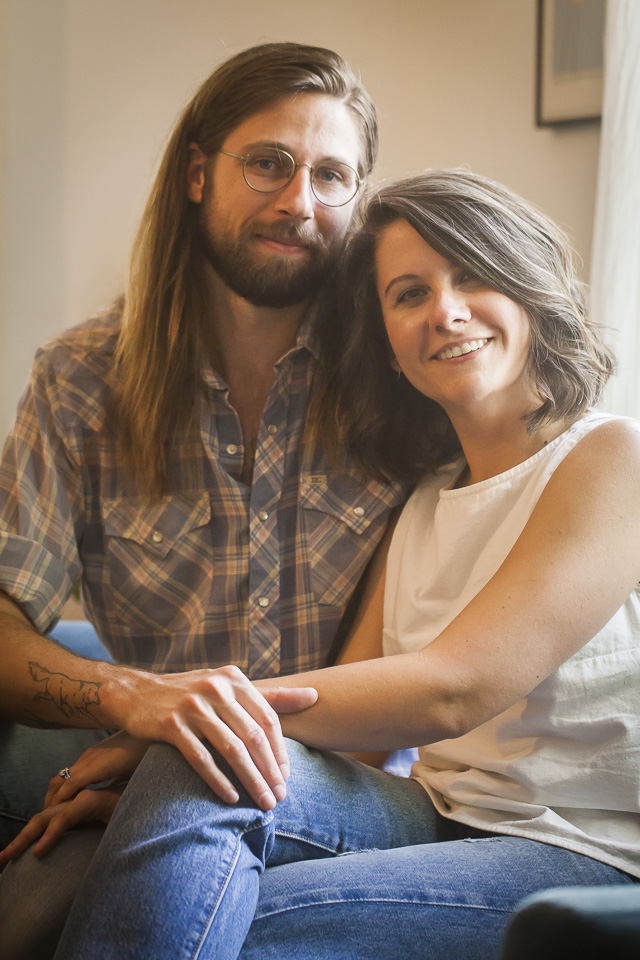 Taylor and Valerie. Photo by Scott David Gordon.
Taylor and Valerie. Photo by Scott David Gordon.
How long have you been a CSA member? Taylor (TC): Two to three years.
When you get your CSA box, what’s your standard plan of action? TC: We bring the box home, pull everything that’s old out of the fridge, and either make stock with the old stuff, or make a big dinner that night and try to use everything up. We just rotate it out.
Valerie (VW): It’s kind of our excuse to clean the fridge. The fresh produce brings a clean vibe to the house, which is really nice.
Who cooks more in the house? TC: Since I’m not here as much, she ends up cooking more often at home than I do. On my days off, I usually cook though.
VW: Yeah, if he’s got a night off, he’ll do the cooking. I offer help, but he’s usually got it under control and I won’t do much. When it’s just me and he’s working, I normally cook veggies and rice, or veggies and beans. That’s my go to. I’m working through the box every night that I’m here. The variety of the veggies keeps my go-to plate interesting.
 Taylor and Bruce. Photo by Scott David Gordon.
Taylor and Bruce. Photo by Scott David Gordon.
What’s your favorite veggie to prep/cook and what’s your least favorite? VW: I love the carrots. Whenever there are carrots in the box, I’m stoked. Especially the rainbow carrots, because they are so beautiful and add so much color to a plate. Maybe it’s because we get so many of them from time to time, but my least favorite would be beets. I love them, but you have to boil them or something first and then store them. It’s just a bit more of a process. Even with juicing them, that’s a process in and of itself.
TC: Tomatoes. There’s nothing much better than a really ripe tomato. I just ordered the first case of the season for Justine’s this week! My least favorite would be collard greens. They aren’t hard to process or anything, it’s just there’s only a couple ways that you can use collard greens. Artichokes, on the other hand, I love, but hate processing. They just take so much work.
What’s your favorite recipe to cook at home? At Justine’s? TC: I make it here and at Justine’s, too. Kind of going off collard greens again, but you can take a collard green leaf, blanche it, cool it off, stuff it with rice, vegetables, and other things, roll it back up, and pan-fry it. Then you serve it with some kind of sauce. It’s kind of like a dolma. When it's served at Justine’s, it’s more of a rice, ground pork, vegetables, and sausage mix rolled into a collard green.
Salt-roasted beets are really good, too. You take a bunch of beets, cover them in salt, herbs, and throw them in the oven. They get seasoned and infused with all the herbs - you pull them out, cool ‘em off, pull the skin off, and cut them. They get perfectly seasoned. You can put thyme and sage in it, and get that taste… they’re really good in salads.
VW: Like I said before, rice and veggies! I don’t really cook much. Taylor put cookbooks on the shelves so that I can start using actual recipes. So, that’s why he kind of takes over when he’s around.
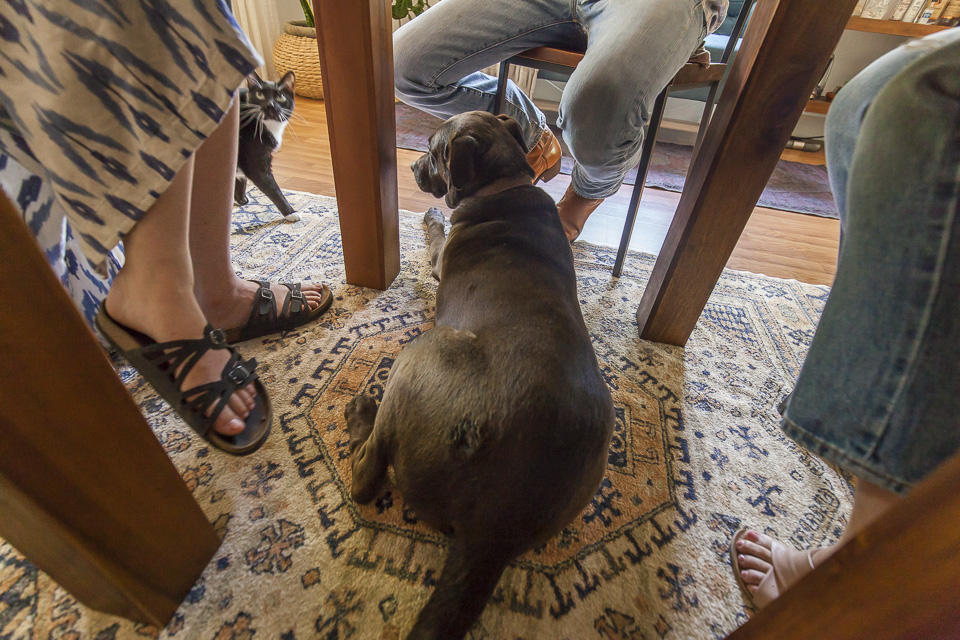 Bruce staying close with Maggie scoping the situation. Photo by Scott David Gordon.
Bruce staying close with Maggie scoping the situation. Photo by Scott David Gordon.
What’s the veggie that stumps you the most when you are cooking? VW: Turnips, for sure.
TC: There are quite a few, but same here. Turnips are good in so many different ways, but kind of like beets, there are only so many ways that you can prepare them and have them be delicious. Beets are so nice because you don’t have to do much to them for them to be good. I guess what stumps me the most is trying to use whatever we get from the farms that you don’t normally eat like carrot tops or fennel fronds. They are half of the veggie that you just got and you don’t want to throw it away. You can pull the leaves off the carrot tops and make pesto with it. The leek tops you can’t do much besides putting it in stock… it tastes like onions. That’s one of the most challenging things about getting farm vegetables. You guys will give us the whole plant and I try and figure out how to use the whole thing, in some shape or form.
Where did you learn to cook? TC: Just working, and working with different people! I’ve been in a kitchen since I was 15 years old. I’ll be 32 in July. I didn’t get really serious until I moved to Austin, though. I would just read books, try recipes, and switch out certain ingredients. I learned a lot from our old chef, Casey, at Justine’s. I just mostly immersed myself and tried to be a sponge over the years.
 Chicken. Photo by Scott David Gordon.
Chicken. Photo by Scott David Gordon.
What did you grow up eating? TC: Beans and rice! My dad made a lot of beans and rice. My mom and dad are both from Alabama, so they both like southern food. We had a lot of southern food. A lot of pot roasts and collard greens… but when they moved to McAllen, where me and my brother were born, they started getting into Mexican food. So we’d have chalupas, tacos, barbecues, and stuff like that. My dad is a pretty big cook.
VW: My mom worked really hard to make sure that we were eating healthy, but at the same time it was more processed stuff. It wasn’t like everything was scratch-made. It was casseroles of things made from canned ingredients. So when I met Taylor, it was all really eye-opening to me that you could make all the things that I had been accustomed to coming out of a can, and that you could know the source of where those ingredients came from.
I would say I’m an expert at snacking. I grew up on a lot of snacks. My mom would pick us up from school and would have a box full of snacks for us, healthy ones, like carrots and smoothies and that kind of stuff.
What is the most difficult part of working with farms and sourcing locally? TC: Honestly, a lot of time, price can be problematic, but that should be overlooked because you’re trying to support your community. The farm is trying to give you a good source of better tasting food than you can get from a large provider that is bringing in produce from warehouses. Another one is availability… you get whatever the farms have. You can’t do anything about that, so you have to read the availability sheet and try and get it as fast as you can. Most of the time JBG doesn’t run out as their list is usually always up to date. However, with smaller farms, it can be a different story. They can sell out of crops really quickly. Regardless, it really isn’t that difficult to work with local farms.
I feel like a lot of places in Austin already work with farms, and maybe everyone should. Most restaurants and chefs that I know, work with some kind of small farm for something. This one girl comes by once a year just to give us dewberries. I will not have seen her for a year, and then she’ll show up with a giant tray of dewberries for sale. That’s really fun, too. To source from the people who are really small and grow a random, small, and specific crop. That’s always a nice surprise when people come in like that.
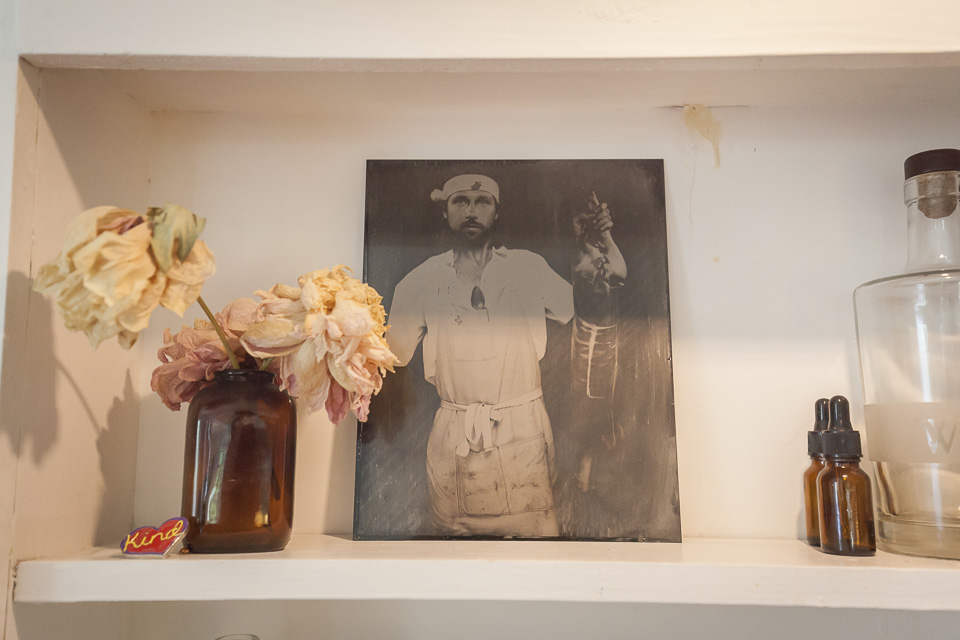 A shelf in their kitchen. Photo by Scott David Gordon.
A shelf in their kitchen. Photo by Scott David Gordon.
What’s the best part of working with farms? TC: Just the quality of the product that you get. It’s really good. The carrots that I get from JBG are probably my favorite snack to have all day. They’re way sweeter than anything that I get from larger providers. The texture is great, the color is awesome, and y’all have them for a long time. Simply put, the food tastes better.
Anything you think that readers would be surprised to learn about the day to day in a kitchen? TC: Maybe just the amount of effort that goes into the food that people order. Obviously, depending on where you go, the effort will be different. At Justine’s during our serving shift, there are only four people cooking the entire shift. It’s really small. I don’t think a lot of people take that into account, one: how busy the kitchen can be, and two: how many people are being a part of that process, because they never see it.
Do you have any advice for a home chef trying to cook with more seasonal vegetables? TC: Read cookbooks, and when you find recipes that call for certain vegetables, like if a recipe calls for yellow onions and leeks are in season… use leeks instead. Try replacing an item in a recipe with what you have available. It gives a whole new twist on the recipe. That will help you learn how to use vegetables, and reprogram your brain in a way to think that they can be used in all these different ways.
 Taylor and Valerie. Photo by Scott David Gordon.
Taylor and Valerie. Photo by Scott David Gordon.
Any quick recipe or technique that you want to share with our readers? TC: I mean, there are so many! Something really easy that you can do with beets, since we’ve been talking about them so much, is boiling beets. When you boil them though, throw in a bunch of herbs, vegetable scrap, ginger, garlic or even some red wine, cool ‘em off, peel ‘em, cut them in half, douse them in some cornstarch, and fry those in a little bit of butter and oil. You get some nice, crispy, flavorful beets.
Disclaimer: be careful when you are frying food at home because you can have an accident. When you fry something, you don’t ever want to go over halfway on your pot, and it’s better to use a pot instead of a pan. If you have a deep cast-iron, put a quarter of an inch of oil in there to fry something. If you want to deep fry something, use an actual sauce pot. Go no more than halfway with the oil, because when you put something in it, all the moisture that’s in it is going to expand really rapidly. It’ll settle down after a while, but if you put too much oil in it, it’s going to expand and you’re going to catch yourself on fire. Things like beets have a lot of moisture in them, so you don’t want to go too crazy with the amount of oil you are using when you fry them.
What item are you most excited about on the Justine’s menu? TC: I just did a celeriac and serrano coleslaw with grilled plum chutney and barbeque-rubbed roasted duck breast. It was my way of doing Texas barbeque but still trying to stay along the French lines. I was really happy with that one. I’m usually really happy with the blackboard that we do at the restaurant. The set menu is really good, everything is fantastic on that, but it’s repetitive... we make it every day. The pork chop is good, and the bolognese is really good. The specials board is where we get to have a little bit of fun, step out of the bistro boundaries, and do a little more creative, seasonal stuff. This is where we can get the weird, seasonal produce and do some cool, creative dishes.
 Having a moment with Bruce. Photo by Scott David Gordon.
Having a moment with Bruce. Photo by Scott David Gordon.
What’s your favorite kitchen gadget? VW: Mine is the immersion blender because it does so much work quickly for you. You just have to make sure everything is soft enough for it to work its magic, but once it is, it just purees anything so easily. Take something like butternut squash, it’s rockhard in the beginning, but once you boil it down and it’s softened up, the immersion blender can turn it into a perfectly blended soup!
TC: Besides my chef knife, maybe the sausage stuffer that we have. Mostly because I just really enjoy making sausages, but it does take a matter of skill… feeling the pressure and how much you need to crank it. There are a bunch of moving parts on it, and it’s satisfying to make a really well-made sausage. I really enjoy using the wood-burning grill, too.
What are you cooking these days at home? TC: When I cook at home, I get to do whatever I want to end up doing. It’s usually along the lines of Texas meets Mexican meets French. Everything I know now is based off of French cooking style and techniques. But, I really enjoy using peppers, spices, vinegars, fire, and smoke. I really do enjoy cooking at home. We don’t have the same luxuries that we have at the restaurant, but it’s still a lot of fun to spend the afternoon working over the grill, listening to music, and being surrounded by loved ones.
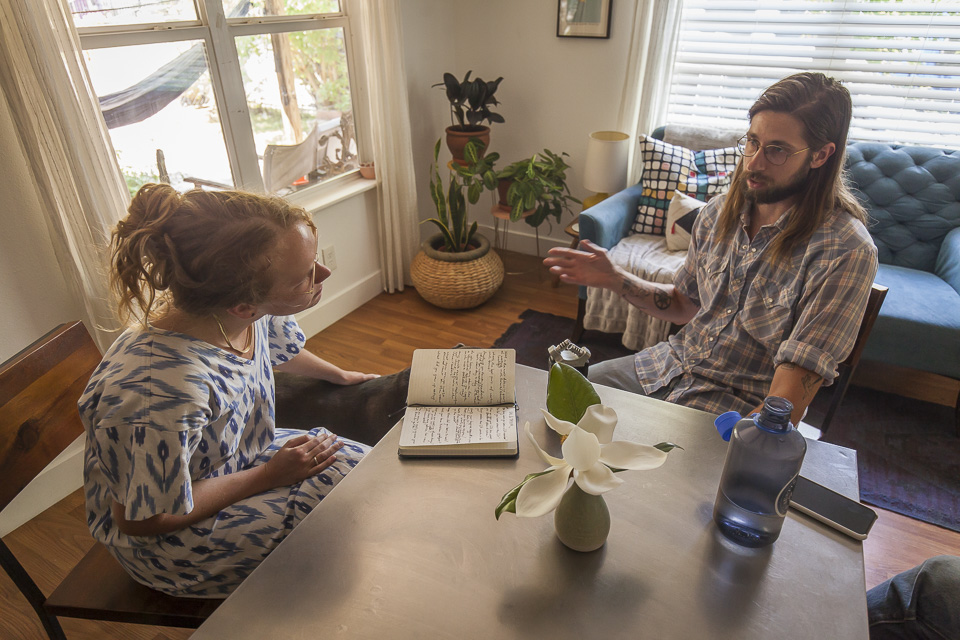 Photo by Scott David Gordon.
Photo by Scott David Gordon.
Do you have any advice for new CSA members? VW: Don’t be afraid to ask questions. When we first started getting the veggies, I didn’t even know what some of the stuff was. We used to pick up at in.gredients and had to change to pick up at the farmer’s market. The change-up was at first a bummer, but now we know that the farmer’s market setup is so nice! All the veggies are out, and everyone that works at the market is super knowledgeable. You might as well use that resource, especially if you aren’t used to cooking seasonally or not sure how to use a particular veggie. Use the recipe cards that come in the boxes, too! The turnips and beets, I didn’t grow up on that stuff, so when we first got them, I was pretty stumped. Now, I can hold my own… you just have to jump in and figure it out.
TC: You kind of nailed it. Be careful of the size of box you select, too. We bought one that was too big for the two of us. If you don’t figure out how to use it before it all goes bad, you end up wasting a lot of food.
VW: Start smaller than you think you need, and figure out how much you actually use, and then choose the size that best fits your lifestyle. I think it takes a lot of trial and error, and mostly, just don’t get discouraged if you’re two weeks in and didn’t use any of their veggies… it takes some time. It definitely did for us.
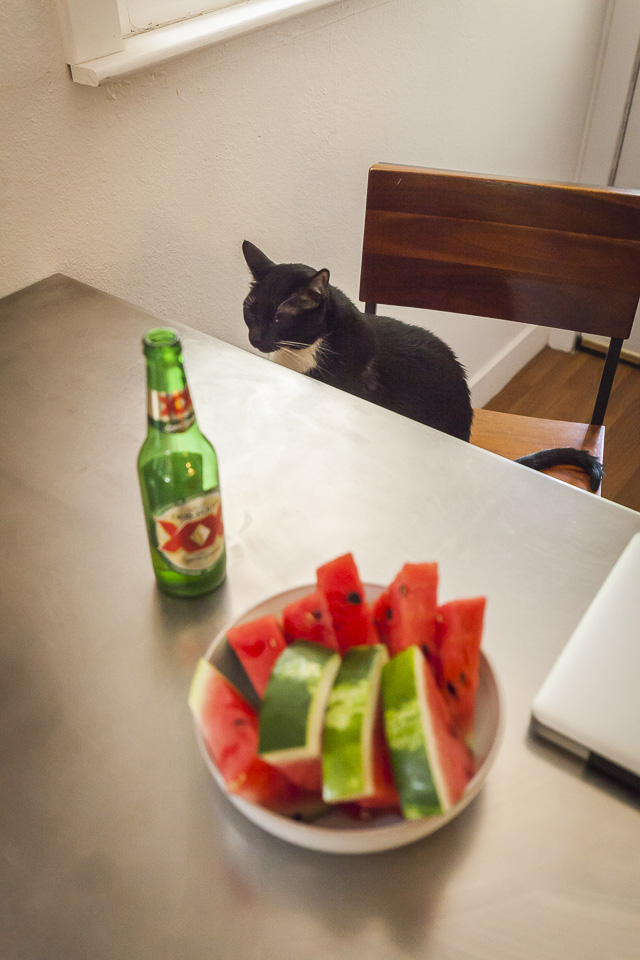 Maggie staying cool with beer and watermelon. Photo by Scott David Gordon.
Maggie staying cool with beer and watermelon. Photo by Scott David Gordon.
What makes the CSA worth it for you guys? TC: It tastes better, in my opinion. A lot of the produce that we get is stuff that you just can’t get at HEB. It’s really nice to have that variety that Valerie mentioned earlier, too. Of course, in certain seasons, like winter, you aren’t growing as many different varieties, but now when you’re getting peppers, tomatoes, and carrots… it’s really awesome.
When you aren’t gushing over your CSA, what do you do? TC: This is a new hot topic, but I’m in an ax-throwing league. Every Tuesday for the next 7 weeks, I’m ax-throwing. I’m going to make it to finals, hopefully. Besides that, I do things around the house and enjoy our time together. I’m the Executive Head Chef at Justine’s - there are many hats under that umbrella. I mostly dream about food, make sure that everyone else can cook it the way I’m dreaming about it, and try to keep the ship afloat.
VW: I am a floral designer. I run my own company called Davy Gray. I mostly do flowers for weddings and events. I’m starting a ceramics class this week out at Laguna Gloria - that should be fun. That’s what I’m going to be doing with my free time!
 Valerie's flower genius.
Valerie's flower genius.
If you were stuck on a desert island, what three things would you bring (water and food excluded)?
VW: Taylor (and all of this three things), ax, and matches.
TC: pocket knife, a compass, and a very large first aid kit.
A huge thanks to Taylor and Valerie for their continued support of the farm, allowing us to feature them, and for being such strong forces of good in our community! ‘Til next time!






 0 ITEMS IN CART
0 ITEMS IN CART 

